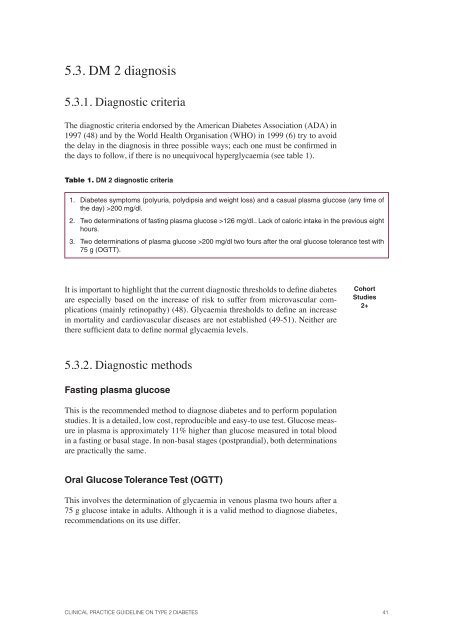2,46 Mb - GuÃaSalud
2,46 Mb - GuÃaSalud
2,46 Mb - GuÃaSalud
Create successful ePaper yourself
Turn your PDF publications into a flip-book with our unique Google optimized e-Paper software.
5.3. DM 2 diagnosis<br />
5.3.1. Diagnostic criteria<br />
The diagnostic criteria endorsed by the American Diabetes Association (ADA) in<br />
1997 (48) and by the World Health Organisation (WHO) in 1999 (6) try to avoid<br />
the delay in the diagnosis in three possible ways; each one must be confirmed in<br />
the days to follow, if there is no unequivocal hyperglycaemia (see table 1).<br />
Table 1. DM 2 diagnostic criteria<br />
1. Diabetes symptoms (polyuria, polydipsia and weight loss) and a casual plasma glucose (any time of<br />
the day) >200 mg/dl.<br />
2. Two determinations of fasting plasma glucose >126 mg/dl.. Lack of caloric intake in the previous eight<br />
hours.<br />
3. Two determinations of plasma glucose >200 mg/dl two fours after the oral glucose tolerance test with<br />
75 g (OGTT).<br />
It is important to highlight that the current diagnostic thresholds to define diabetes<br />
are especially based on the increase of risk to suffer from microvascular complications<br />
(mainly retinopathy) (48). Glycaemia thresholds to define an increase<br />
in mortality and cardiovascular diseases are not established (49-51). Neither are<br />
there sufficient data to define normal glycaemia levels.<br />
Cohort<br />
Studies<br />
2+<br />
5.3.2. Diagnostic methods<br />
Fasting plasma glucose<br />
This is the recommended method to diagnose diabetes and to perform population<br />
studies. It is a detailed, low cost, reproducible and easy-to use test. Glucose measure<br />
in plasma is approximately 11% higher than glucose measured in total blood<br />
in a fasting or basal stage. In non-basal stages (postprandial), both determinations<br />
are practically the same.<br />
Oral Glucose Tolerance Test (OGTT)<br />
This involves the determination of glycaemia in venous plasma two hours after a<br />
75 g glucose intake in adults. Although it is a valid method to diagnose diabetes,<br />
recommendations on its use differ.<br />
CLINICAL PRACTICE GUIDELINE ON TYPE 2 DIABETES 41

















